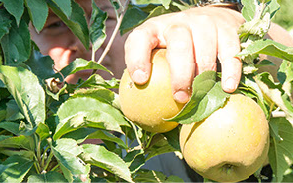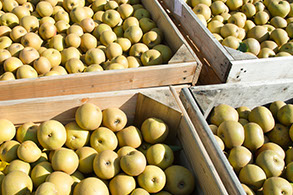
CHANDLER & DUNN
FARMING FOR THE FUTURE

APPLES
"Fusing modern science and traditional farming to produce great tasting fruit for quality retailers."
We grow a wide variety of apples and are constantly testing new varieties. We aim for a grade 1 ‘top supermarket quality’ crop, and any apples below that standard are sold on for juicing.
Cox
 We grow two varieties - Queen Cox and La Vera Cox.
We grow two varieties - Queen Cox and La Vera Cox.Varieties of Cox's Orange Pippin are among the best in quality of all the English dessert apples. They can be eaten out of the hand or sliced. Not recommended for cooking.
Uses: Eating apple often blended with other varieties in the production of cider.
Origin: A traditional eating apple, grown in Kent since the 19th century.
Colour: Orangey red in colour.
Character: Medium sized, yellow-white, fine-grained, crisp, and very juicy.
Flavour: Distinctive aromatic taste.
Galas
 We grow a wide variety of highly red Gala apples, including Mondial, Brookfield, Galaxy and Schniga.
We grow a wide variety of highly red Gala apples, including Mondial, Brookfield, Galaxy and Schniga.One of the biggest selling eating apples in the UK.
Uses: Eating apple, can be added to salads or cooked, also suitable for creating sauces.
Origin: A Golden Delicious and Kidd's Orange Red cross, first planted in New Zealand, and grown commercially in the UK since the 1980s.
Colour: Usually red in colour with a portion being greenish or yellow-green, vertically striped.
Character: Small, firm apple with thinner skins than most apples yet still fairly resistant to bruising.
Flavour: Crisp, sweet, aromatic, mild flavour.
Jazz
 One of the biggest selling eating apples in the UK.
One of the biggest selling eating apples in the UK.Uses: Eating apple, popular with children.
Origin A Royal Gala/ Braeburn cross (descended from the Cox’s Orange Pippin) - first propagated in New Zealand in 1985. The Jazz Apple gets its deliciously sweet taste and from the Braeburn and inherits its crunchy delicious texture from the Royal Gala.
Colour: Blend of Yellows and reds.
Character: Small and crisp, dense texture, keeps well.
Flavour: Amazing zingy sweet taste with a champagne effect that sparkles in mouth.
Egremont Russett
 A classic English russet apple from the Victorian era.
A classic English russet apple from the Victorian era.Uses: Eating apple which also works well in savoury salads and with cheese.
Origin: First recorded in 1872, and is believed to have been raised by the Earl of Egremont at Petworth in Sussex.
Colour: Dull orange-yellow colour with russeting all over the apple.
Character: Medium sized, thin dry skin with pale cream coloured flesh which is moist rather juicy.
Flavour: Delicate nutty flavour, sweet and dry - reminiscent of a firm pear.
Daliclass
 Uses: Eating.
Uses: Eating.Origin: An Elstar/Pilot cross from France, first introduced in 2010 - a cultivar from an Orange Pippin.
Colour: Red/orange flush skin with while to pale yellow flesh.
Character: Medium sized.
Flavour: Sweet and sharp.
Early Windsor
 Raised in Germany as Alkamene in the 1930's - a cross between Gehiermat Dr Oldenburg & Cox's Orange Pippin. Re-named Early Windsor for the UK market in 1996 but often called Sweet Lilibet (following a competition among school children to select a new name).
Raised in Germany as Alkamene in the 1930's - a cross between Gehiermat Dr Oldenburg & Cox's Orange Pippin. Re-named Early Windsor for the UK market in 1996 but often called Sweet Lilibet (following a competition among school children to select a new name).Available in Supermarket towards the end of September this eating apple looks a little like Cox with its faint russet striping.
Uses: Eating and makes great tasting juice
Origin: A red sport mutation of Alkemene, grown commercially on a small scale in the UK
Colour: orange/red stripes over yellow.gold background colour.
Character: Medium sized, crisp, juicy, refreshing flesh, firm but less dense than a cox
Flavour: Clean tasting with a rich aromatic honey flavour.
Braeburn
 Originating from New Zealand, the its exact parentage is unknown. Braeburns are thought to be a relative of the Lady Hamilton and Granny Smith apples, as both varieties were growing in the orchard where the Braeburn apple was first discovered.
Originating from New Zealand, the its exact parentage is unknown. Braeburns are thought to be a relative of the Lady Hamilton and Granny Smith apples, as both varieties were growing in the orchard where the Braeburn apple was first discovered.Uses: Eating and cooking
Origin: A relatively new apple introduced to the UK in 1950s.
Colour: Red/orange vertical streaky appearance on a yellow/green background. Its colour intensity varies with different growing conditions.
Character: Firm to the touch, crisp and juicy, thin skin.
Flavour: Distinctive aromatic taste. Its sweet-tart flavour mellows just slightly when cooked and will compliment both sweet and savoury dishes. When raw, best served slightly chilled. Slice and add to salads and sandwiches or serve on a cheese board.
Cameo
Cameo is a very modern apple
Uses: Eating and cooking in both sweet and savoury dishes. Resistance to browning when cut makes them ideal for sandwiches, salads and garnishes. Dense flesh holds up well when cooked.
Origin: Discovered by chance by the Caudle family in a Dryden, Washington orchard in 1987. Cameo is blelieved to be of the Red and Golden Delicious.
Colour: Red stripes develop just before harvesting. Pickiing at this time ensures skin maintains thin and delicate texture for which Cameo's are known.
Character: Flesh is dense and creamy white to yellow with a crisp and juicy texture.
Flavour: The perfect balance of sweet and tart with nuances of both honey and citrus.
Smitten
Another new apple to fall in love with - a foodies delight!
Uses: Eating and often blended with other varieties in cider production. Pair with cheese or peanut butter for a snack or cook/bake into desserts or with pork or chicken.
Origin: The Millenium's search for t he world's most irresistible eating apple began in New Zealand and ended with Smitten. First grown in 1995 (but not named until 2010), its grandparents are Falstaff, Fiesta, Braeburn and Gala.
Colour: Brilliant white flesh with a yellow base and cheeky blush.
Character: A large and beautiful, naturally-coloured, healthy and flavourful apple. Unbelievably crunchy.
Flavour: Sweet with a hint if tart - it contains notes of cider, flowers, oranges, and wine, though in general the flavour is subtle not overpowering.
Ladina
A flavourful Swiss dessert apple developed in the early 2000s.
Uses: Eating apple.
Origin: Developed as part of a breeding programme in 1999 at Wädenswil (Switzerland) by crossing Topaz with Fuji.
Colour: 80% Bright red.
Character: The flesh is yellowish, firm, fine-grained.
Flavour: Sweet and juicy with fine of flavours of peach and lychee.
Kissabel
A new eating apple from France, developed during the 2000s.
Uses: Eating apple.
Origin: Developed over twenty years by French breeders who started crossing wild red fleshed apples with high quality varieties.
Colour: Depending on the variety skin colours vary from yellow to red and the flesh colour varies from red to pink.
Character: The originators define Kissabel as being simple and natural with “A good feeling and zest of discovery”.
Flavour: Juicy and firm, it is well-balanced and delightful to eat.

CHANDLER & DUNN LTD




